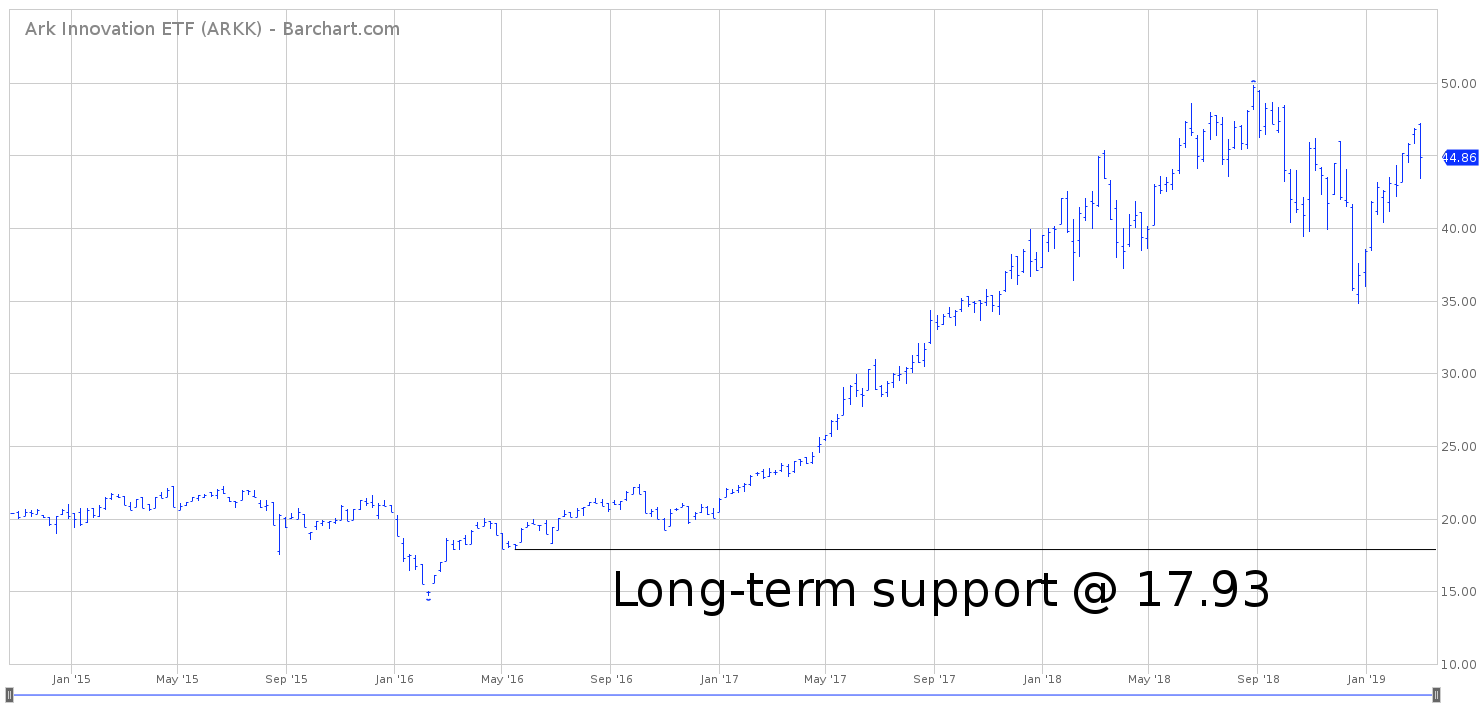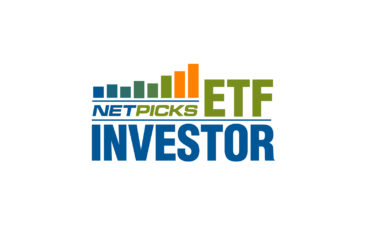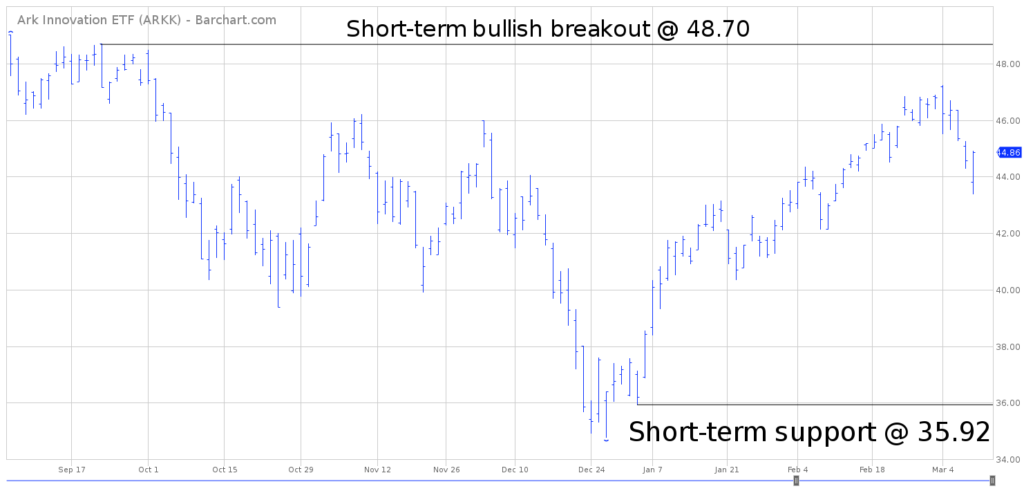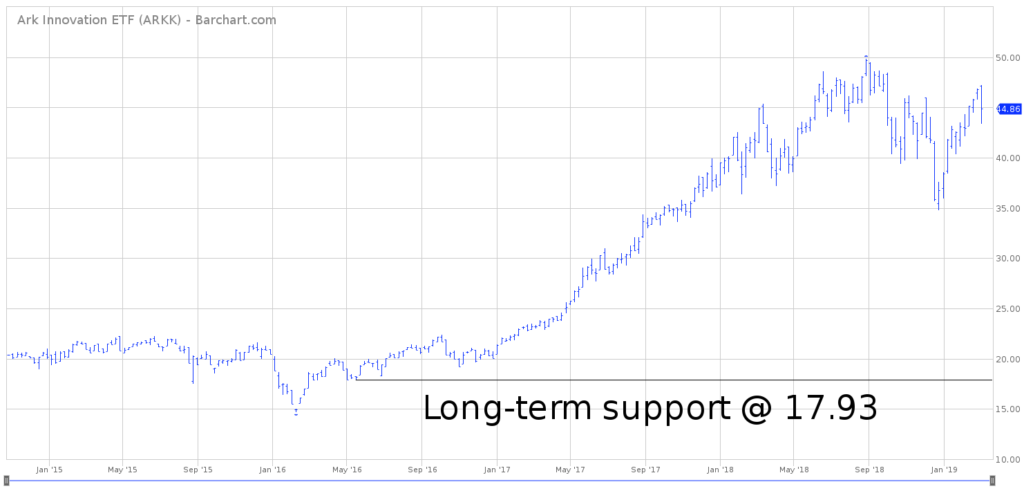

ARK Innovation ETF (ARKK)
Key Statistics
Minor Support Level 35.91 Minor Resistance Level 48.70
Major Support Level 17.93 Major Resistance Level 55.39
Minor Buy Signal 49.87 Minor Sell Signal 34.75
Major Buy Signal 59.53 Major Sell Signal 14.57
BRIEF OVERVIEW – ARK Innovation ETF
One hundred years from now, people are going to look back on the first two decades of the 21st century and quickly realize that this was a great time to be alive on this planet, particularly as it relates to new disruptive technologies and innovation solutions. We’ve only just started to scratch the surface. Tremendous opportunities await investors and entrepreneurs as they participate in this exciting technological frontier.
Today, we find ourselves in the middle of the Information Age, which is characterized by a rapid shift from traditional industries to an economy based on information technology. Although it’s always difficult to pinpoint a specific starting point for these major shifts in economic history, most financial historians agree that the Information Age began in 1956, with the introduction of the mainframe computer. Over the course of the past 60+ years, the Information Age has followed a fairly predictable 14-year technology cycle. Each cycle made an important contribution to the advancement of global technology.
- 1954 Mainframe computer
- 1968 Microchip
- 1982 Personal Computer
- 1996 Internet
- 2010 Smart Phones
- 2024 Blockchain
As you can see, each 14-year cycle coincided with the release of a new technological product or service. The next important area of concentration lies in the field of blockchain technology (which also includes Bitcoin and smart contracts). Many people will argue that blockchain has been in existence since 2009, when Satoshi Nakamoto unveiled Bitcoin. On the surface, this is true. Blockchain technology was introduced (along with Bitcoin) by Nakamoto in January 2009. However, the technology is still in its infancy stage. It won’t reach mainstream adoption until 2024.
During the past five years, several mutual funds and ETFs have explored the idea of investing in “disruptive technologies.” The objective of these funds and ETFs is to find global companies that enter traditional markets with new digital forms of production and distribution, and are likely to disrupt an existing market or value network.
The ARK Invest family of ETFs created the ARK Innovation ETF on October 31,2014. The ticker symbol is ARKK. The objective of the fund is to provide investors with exposure to companies that rely on (or benefit from) the development of new products and services, technological improvements and advancements in scientific research. ARKK currently has 37 different holdings. The top five holdings include Tesla Inc, Stratasys Ltd, Invitae Corp, Nvidia Corp and – momentum, they must generate a weekly close below 35.91. At least for now, the path of least resistance is to the upside.
Based on the Aroon Oscillator, ARKK has a moderately overbought reading of +64. The Aroon Oscillator is programmed differently than most stochastic indicators. The oscillator fluctuates between -100 and +100. A reading of 0 would indicate a neutral position. Therefore, a reading of +64 with ARKK is considered slightly overbought. Most likely, the market is very close to a short-term top. In fact, the top may have occurred @ 47.24 on 4 March.
LONG-TERM VIEW – ARK Innovation ETF
Investing in disruptive technologies is a relatively new concept within the mutual fund and ETF industry. Many funds have been in existence for less than five years. The prevailing strategy among the money managers within this sector is to use a “thematic investing” approach. The objective of thematic investing is to capture exposure to secular trends taking shape within an economy. These trends can occur as a result of demographic shifts, changes in government policy and/or advances in technology.
During the past few years, several thematic investing trends have converged together at the same time to offer some exciting opportunities for those investors who are willing to take a long-term approach. Based on the fact that thematic investing is a fairly new idea, there is no real-time performance data to compare this approach to other strategies. Therefore, investors must be willing to accept the added risk of not having a proven track record.
Disruptive technologies are impacting our day-to-day lives rather dramatically and are forcing industries to change the way they do business. Those companies that are at the forefront of innovation have an excellent opportunity to provide significant growth opportunities for their investors.
Currently, there are ten major themes within the overall framework of thematic investing. Very briefly, let’s review each theme.
Healthcare Innovation involves the development of new diagnostic procedures, therapies, drugs and medical devices. These advances range from new pharmaceutical procedures to surgical robots.
Internet of Things (IoT) is the inter-working of physical devices, buildings and other items embedded with electronics, software and sensors which enables these objects to communicate with one another, as well as collect and exchange data.
Clean Energy is energy and electricity generated by power stations using renewable sources such as sun, wind, waves and water. These energy sources release minimal amounts of greenhouse gases.
Cloud Computing is the delivery of computer services over the internet. If you use an online service to send e-mail, edit documents, stream movies or store pictures, it’s likely that cloud computing is doing all the work behind the scenes.
Data and Analytics is a disruptive technology which enables business users to process data much more efficiently. This allows these businesses to reveal insights hidden in the data, which were previously too costly to extrapolate.
FinTech describes an emerging financial services sector. Basically, the term is used to describe any technological innovation in the financial sector, including innovations in financial education, retail banking, investment banking and blockchain technology.
Robotics and AI involves an attempt to re-create the human thought process, with an ultimate objective of developing a man-made machine with our intellectual abilities.
Cybersecurity involves protecting information and systems from major cyber threats, such as cyber terrorism, cyber warfare and cyber espionage. Due to the amount of damage cybercrimes can cause, cybersecurity is (arguably) the most critical part of any government security strategy.
3D Printing is achieved by laying down successive layers of material until the object is created. 3D printing has enormous disruptive potential in a wide variety of industries, including fashion, medicine, commercial art, footwear and construction.
Mobile Payments includes everything from paying with your phone, swiping your card on a tablet, to transferring money to family members who live in other countries. If we include the use of cryptocurrencies in the equation, the disruptive potential for mobile payments is huge.
In terms of ARKK, the managers of the ETF have narrowed their investment focus to five major areas: DNA sequencing, robotics, energy storage, next generation computing and blockchain technology. They believe these five specific areas offer the greatest upside potential over the course of the next 10 to 20 years.
Investing in disruptive technologies is one of the very few areas where investors should not be too concerned about the current state of the global economy. Why? Because these disruptive investments are typically in the very early stages of their product life cycle. Therefore, the current state of the economy is not very important to the long-term success of these investments.
In regard to the long-term view of ARKK, the bulls are definitely in control of the ETF. The next level of resistance is 55.39. The bears need a weekly close below 17.93 to generate a bearish chart pattern. Although the ETF has only been in existence since 2014, the momentum is clearly in favor of the bulls.
SHORT-TERM CHART – ARK Innovation ETF
Please review the 6-month chart of ARKK. During the past eight weeks, the bulls have been able to recapture the short-term chart pattern. The next bullish breakout occurs at 48.70. A weekly close below 35.91 is required in order to reverse the trend from bullish to bearish.
LONG-TERM CHART – ARK Innovation ETF
ARKK has only been in existence since October 2014. Therefore, the attached chart only displays 4 ½ years of activity. Based on the data that’s available, the chart pattern is definitely in favor of the bulls. The trend will remain bullish as long as ARKK stays above 17.93 on a weekly closing basis.



